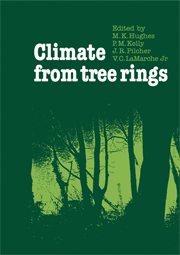1 - DATA ACQUISITION AND PREPARATION
Published online by Cambridge University Press: 05 October 2010
Summary
INTRODUCTION
The Editors
Where trees form annual growth layers, there exists the likelihood that the characteristics of those layers reflect the conditions under which they were formed. Differences in annual growth layers, which are seen as tree rings, may be parallel in many trees within a region indicating that some common set of external factors is influencing growth. Such similarities in growth variation may be strong and spatially extensive. Where this is true, it is reasonable to assume that the external agents forcing the pattern of variability common to trees in a region relate to climate. There are no other environmental factors likely to act on the same range in the space, time, and frequency domains. It should be possible, therefore, to extract a record of the climate variables recorded in the rings of wood formed in the past. This is the basic assumption of dendroclimatology.
Many tree species in the temperate regions show patterns of common year-to-year variability in one or more measure describing the state of the tree ring. This phenomenon has been exploited by scientists in two main fields: dendrochronology (tree-ring dating of wood found in archaeological, geological, or other contexts) and dendroclimatology (the use of tree rings as proxy climate indicators). Both fields depend heavily on the identification and verification of patterns of common yearto- year variability in many wood samples from a site or region.
- Type
- Chapter
- Information
- Climate from Tree Rings , pp. 1 - 31Publisher: Cambridge University PressPrint publication year: 1982



